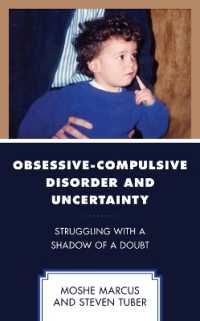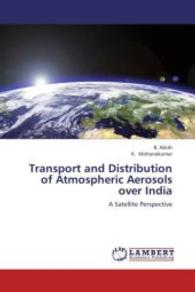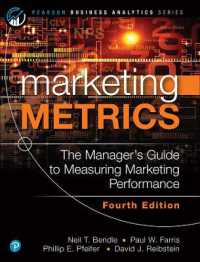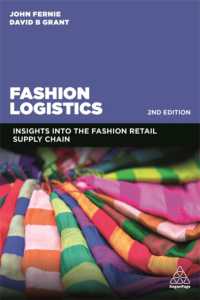Full Description
Mathematical Literacy in the Middle and High School Grades gives future and current middle and high school classroom teachers the concepts and practical, hands-on suggestions, activities, lesson plans, skills, and tools they need to enhance and enrich their students' mathematics learning. From its opening overview of the theory behind a variety of new strategies for teaching math to its everyday, concrete assistance, the book helps teachers find and use engrossing ways to introduce math concepts through stories, using hands-on activities to reinforce the concepts. Included are ready-to-use activities busy teachers can incorporate "as is" or adapt to fit their particular classrooms and their students' individual needs.
Contents
IntroductionWhy This Book and Why These AuthorsHow to Use this BookSection I: Mathematical LiteracyChapter 1. Exploring the Porous Boundary Between Doing Mathematics and Understanding TextIntroduction to Mathematical LiteracySidebar: Notes on Standards of Practice Used in This TextTiny Children Love to Count-Where Do We Lose them?One Text, Many Lessons in Math LiteracyCo-teaching with Computer Educators to Enhance Word Analysis AssignmentsOrdinal Numbers, Cardinal Numbers, Numerals, and Other Words Expressing QuantityGeometry-The Shape of ThingsA Question of TimeWhat's the Likelihood of Finding Math in Your Pleasure Reading?Looking for Mathematical Text in Your Student's WorldClassroom Discussion Questions for ArtifactsHelping Students Find Math in Unexpected PlacesLesson Plan 1-1: Interested in Getting Rich? --An investigation of simple interest, compound interest, and exponential functions based on ArtifactsReferencesChapter 2. Reading Strategies: Making Meaning of TextIntroductionHow Does Reading Mathematics Differ From Other Kinds of Reading?How Can We Help Students Make Meaning From Mathematical Text?Prior Knowledge: An ExperimentUsing Reading Activities to Enhance Student UnderstandingReading Guide: Alice in WonderlandLesson Plan 2-1: The Universal Book of Mathematics Vocabulary SquaresLesson Plan 2-2: Red Blazer Girls Multi-Column JournalBibliographySection II: Exploring Mathematical TextChapter 3. Introduction-Fiction and Mathematical Literacy: Finding Universal Truths in Made-Up StoriesMathematics Is Everywhere, Even in Fairy TalesComments from the Classroom by Alyson LischkaFinding Math Where You Least Expect It by Mary Anna EvansAnnotated Bibliographies - FictionFiction Recommended for Middle Grade ClassesFiction Recommended for High School ClassesLesson Plan 3-1: The Wrong Ratio Can Be Deadly: An Investigation of Ratios based on EffigiesReferencesChapter 4. Nonfiction: The Place Where True Stories and Mathematics IntersectIntroductionAnnotated Bibliography of Nonfiction Books Suitable for Middle and High School ClassesActivity BooksReference BooksConcept BooksBiographiesUsing Technology to Explore Other Nonfiction FormatsTextbox 1: One Blogger's Perception of the Beauty of Math by Brent YorgeyAnnotated Bibliography of Mathematical BlogsNonfiction in the Math Classroom Lesson Plan 4-1: "Grappling Over Grades" Anticipation GuideLesson Plan 4-2: Archimedes R.A.F.T.ReferencesChapter 5. Picture Books: Where Math, Text, and Illustrations CollideIntroductionTextbox 1: Cindy Neuschwander and Sir CumferenceTextbox 2: Fibonacci in Nature by Sarah Campbell Activity: Sketching (or Eating) Your Way Through the Text with The Lion's ShareAnnotated Bibliography of Picture Books for the Middle and High School GradesLesson Plan 5-1 - Anticipation Guide for Reflections in Nature by Jane YolenReferencesSection III: Literacy and Mathematics in the CultureChapter 6. Poetry and Music: A Most Mathematical Approach to WordsPoetryMath and MeterMusic Math as a Springboard to Verbal Creativity"Midsummer" by Mary Anna Evans"the curvature of spacetime" by Johnny MasiulewiczPoetry for Poetry's SakeLoving Words the Way Zero Loves One by Lola HaskinsActivity 6-1: Poetry CountsActivity 6-2: Fractions, Poetic Meter, and Spoken EnglishActivity 6-3: Relating Vibrational Frequency to Pitch with RatiosActivity 6-4: Rhythm and Language-Bringing Poetry, Music, and Mathematics TogetherActivity 6-5: Catenaries, Large and Small-Visual CalculusReferencesChapter 7. Environmental Print: Math in Daily LifeDefinition of Environmental PrintWhere to Find Environmental PrintIdeas for Using Environmental Print in ClassLevel 1: Practicing ProblemsLevel 2: Constructing Knowledge About Problem SolvingLevel 3: Thinking Critically About Mathematics and LiteracyA Level 1 Example-Checking the Fine Print for Ways to Practice Mathematical SkillsA Level 1 Hands-On Activity: Find the Math in this Simulated Frequent Buyer ProgramA Level 2 Example-Assembling Knowledge As It Pertains To Citizenship...The Impact of Polls on ElectionsA Level 2 Hands-On Activity: A Poll Is Only As Good As The Questions AskedA Level 3 Example-Think Critically About Research Studies: Do Statistics Lie?A Level 3 Hands-On Activity: How Can Two Contradictory Studies Be True?So what? Using math to make people careReferencesChapter 8. Mathematics and the Electronic Culture: Social Media, Gaming, and Reality ShowsIntroductionA Word About Constant Change: How Will You Deal With It Over the Course of Your Career?Social mediaGames and Their Relationship to MathSimulation Games: The Algebra ConnectionArithmeticRatios and RatesLinear EquationsOther opportunities to enhance literacy using computer gamingGeometry in computer gamingTelevision Reality ShowsConclusionLesson Plan 8-1: Tweets that Go On Forever and Ever...Lesson Plan 8-2: What Can Reality Shows Teach Us About American Electoral Politics?ReferencesChapter 9. ConclusionChapter 10. AppendicesAppendix A: Selections from ArtifactsAppendix B: A Concordance of the Words Used in the Opening Passages of Artifacts, by Mary Anna Evans








